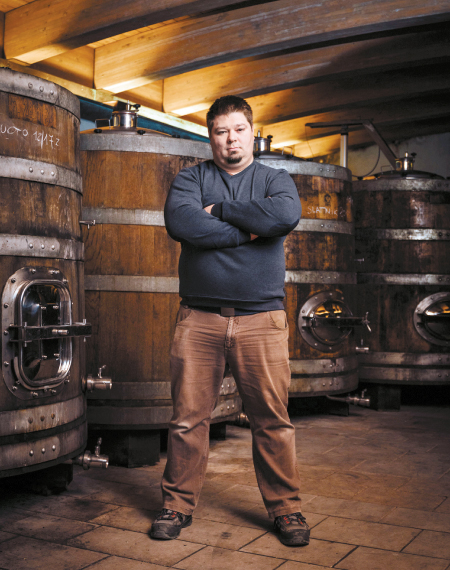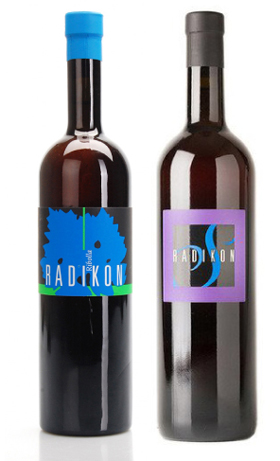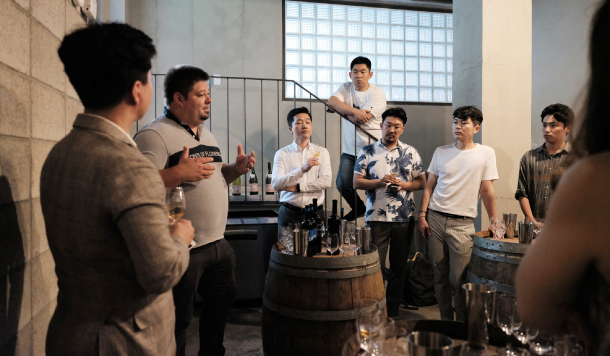For wine, orange is the new red : Winemaker Sasa Radikon brings a natural flavor to Seoul

Sasa Radikon, the winemaker behind the Italian wine Radikon, poses at his winery. [SUSTAINWORKS KIM JIN-HO]
Sasa Radikon, one of the leading makers of natural Italian and orange wine, came to Korea for the first time last week to introduce his ideas behind winemaking. Natural wine, although there is no exact definition, is commonly known as wine made with no chemicals or additives. Radikon is also made as “natural” as possible because the winemaker believes in “[adding] nothing and [taking] out nothing” from fermented grapes.
“If you start to take something out, you need to start adding something else and there you lose a lot of things you have worked for [in the vineyards],” said Radikon.
Orange wine is the term widely used to refer to white wine fermented with grape skins, while most white wines are made with grapes fermented without. Orange wines tend to be orange in color, hence its name. Radikon started experimenting with orange wine in the 1990s and began focusing on orange wine in 1997.

As global demand for more environmentally-friendly products continues to grow, natural wines have found many fans worldwide. Due to the increased demand for his wine, Radikon says that his product sells out each season even before the wine is bottled. To better cater to fans all over the world waiting to get their hands on the bottles, the winemaker has purchased more land in order to make more wine. His 12-hectare vineyard is now 18 hectares, but he says that, even if the demand gets higher, he won’t go over 20 hectares.
“That’s how much I can handle,” said Radikon, adding that, if his vineyard gets too large, he won’t be able to find time to travel internationally to promote his wine. He says he couldn’t have imagined when he first decided to join the family business at 14 that his particular style of orange wine and natural wine would enjoy the popularity it is enjoying right now.
“We are one of the first ones to start making orange wine, but what is more important in the market is if there are followers,” said Radikon. “Without them, the first person is just someone crazy.”
However, even with the increased amount of wine being produced, no restaurants or bars will see a drastic increase in their allocations.
Instead of releasing all of the bottles to bars and restaurants or importers in different countries, Radikon controls the amount of bottles each country gets in order to build a sturdy consumer base. This tactic of playing a little hard to get, where some places have his wine and some places have sold out, is used to keep people interested.
“I don’t want to be a rock star just for one year,” said Radikon, explaining that building a base for a wine when it first enters into a new market leads to creating long-term fans instead of those who may not come back for the bottle after just one try.

Winemaker Sasa Radikon of Italian wine Radikon, second from left, talks with local sommeliers and wine connoisseurs while tasting his wine during his first visit to Seoul last week. [VIN.V]
“That’s why I came to Korea this time, because this is a market I can really work with,” he said. “Young people in Asia seem to be more open and quick to try than those in Europe when it comes to natural wines.”
Plus, the idea that orange wine could match well with the hot spices used in Korean food drew the winemaker to the market.
“When you eat spicy food, the [hot taste] comes a bit later in your mouth, and orange wine tends to stay in your mouth for a few minutes, not only seconds, so it is probably a good match based on what I have tried,” said Radikon.
For those trying Radikon wines for the first time, he suggests going with a normal-sized bottle, often called the S line, pictured below right. Wines in this line were created by Sasa Radikon himself after years of making the existing labels his late father created. He said these bottles are designed to introduce orange wine to novice drinkers.
“The wines we make have evolved since 1997, and the people who have drunk our wine since then are used to the flavors, but it could be a bit much for beginners,” said Radikon.
To try the evolved version of the wine, go for either the 500 or 1,000-milliliter version with a skinnier bottle. These can be kept for longer, while the S line wines are designed to be consumed right away.
“People now drink less and less, and that’s why they look for wines they like and options that suit their body better.”
BY LEE SUN-MIN [summerlee@joongang.co.kr]










with the Korea JoongAng Daily
To write comments, please log in to one of the accounts.
Standards Board Policy (0/250자)